The butterfly pea plant ( Clitoria ternatea ) (නිල් කටරොළු ) – By Malsha – eLanka
Clitoria ternatea, commonly known as butterfly pea or blue pea vine, is a plant species in the Fabaceae family. It is native to South-East Asia and is found in countries such as India, Thailand, Malaysia, and Indonesia. The plant is named after the shape of its flowers, which are reminiscent of a butterfly.
The butterfly pea plant is a perennial vine that can climb and spread, and it is known for its attractive blue flowers. The flowers are vibrant blue in color and have a unique shape with a standard petal that resembles the body of a butterfly and two smaller lobes that resemble the butterfly’s wings. Additionally, there are white and pink varieties of this plant.
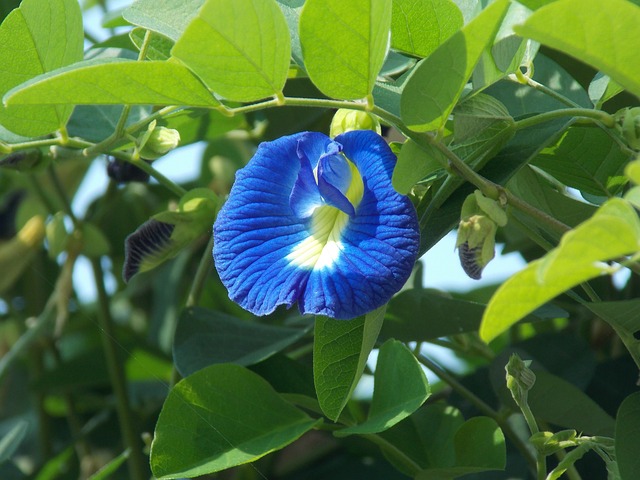
Apart from its ornamental value, Clitoria ternatea is also known for its various uses and benefits:
- Culinary: The flowers are used to add a natural blue color to certain dishes and beverages. They can be steeped to make a vibrant blue tea or used as a natural food coloring for rice, desserts, and other culinary creations.
- Traditional Medicine: In traditional medicine systems like Ayurveda and Thai traditional medicine, butterfly pea flowers have been used for various medicinal purposes. They are believed to have antioxidant properties and are used to promote hair growth, improve eyesight, and enhance memory, among other health benefits.
- Herbal Tea: Butterfly pea flower tea is known for its potential health benefits. It contains antioxidants and is believed to have calming and stress-relieving effects.
- Natural Dye: The flowers have been used to create natural dyes for textiles and crafts due to their intense blue color.
- Agricultural Uses: In some regions, the butterfly pea plant is grown as a cover crop, which helps enrich the soil with nitrogen and provides erosion control.
It’s important to note that while Clitoria ternatea has some traditional uses and potential health benefits, scientific research is ongoing to fully understand its properties and effects. As with any herbal remedy or supplement, it’s essential to consult with a healthcare professional before using it for medicinal purposes.
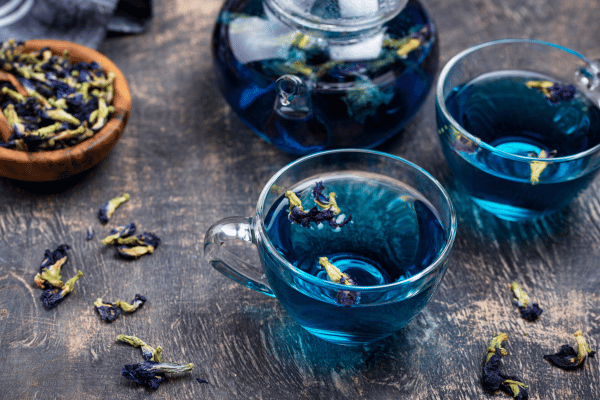
Butterfly pea (Clitoria ternatea) has been associated with several potential health benefits. However, it’s important to note that scientific research is ongoing, and more studies are needed to establish these benefits conclusively. Here are some of the potential health benefits of blue butterfly pea:
- Antioxidant Properties: Blue butterfly pea flowers are rich in antioxidants, such as anthocyanins, which may help combat oxidative stress and reduce cellular damage caused by free radicals.
- Anti-inflammatory Effects: Some studies suggest that butterfly pea may possess anti-inflammatory properties, which could help in reducing inflammation in the body.
- Cognitive Health: There is some evidence to suggest that the flavonoids found in butterfly pea flowers might have neuroprotective effects and could potentially enhance memory and cognitive function.
- Stress Relief: Butterfly pea tea is often regarded for its calming and stress-reducing effects, which could be attributed to certain bioactive compounds present in the plant.
- Eye Health: Traditionally, butterfly pea has been used in traditional medicine systems like Ayurveda to promote eye health and improve eyesight.
- Hair Health: In some cultures, butterfly pea is used as a hair tonic to promote hair growth and reduce hair fall.
- Potential Anti-Diabetic Properties: Some animal studies have shown that butterfly pea extracts may have antidiabetic effects by helping to regulate blood sugar levels.
- Skin Benefits: Butterfly pea extract has been used topically in certain skincare products for its antioxidant properties and potential benefits for skin health.
It’s important to keep in mind that while butterfly pea shows promise as a beneficial plant, most of the available research has been conducted on animals or in test tubes. More human studies are needed to fully understand its effects on human health and determine the appropriate dosages and safety profiles.
As with any herbal remedy or supplement, it’s essential to consult with a healthcare professional before using butterfly pea for medicinal purposes, especially if you are pregnant, nursing, or have any underlying health conditions or are taking medications. Additionally, butterfly pea should not be used as a replacement for medical treatments prescribed by healthcare professionals.
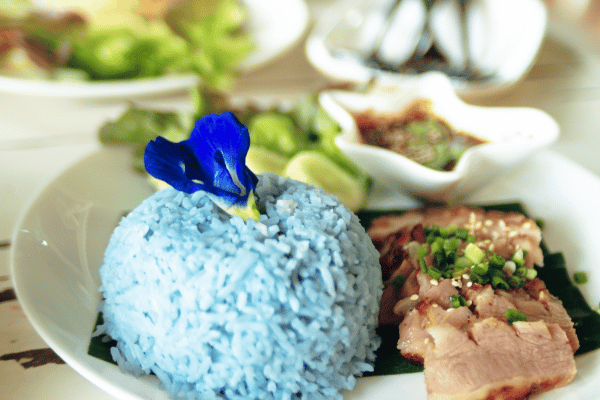
Blue butterfly pea flowers are often used to add a natural blue color to various culinary creations. The vibrant blue color can be a delightful addition to dishes and beverages. Here are some common foods and drinks that can be prepared using blue butterfly pea:
- Butterfly Pea Flower Tea: One of the most popular uses of blue butterfly pea is to make a herbal tea. To prepare the tea, simply steep dried butterfly pea flowers in hot water. The longer you steep, the deeper the blue color becomes. Lemon juice can be added to change the color from blue to purple due to the change in pH.
- Rice: In some Asian countries, particularly in Thailand and Malaysia, blue butterfly pea flowers are used to color rice dishes. When cooked with rice, the grains take on a beautiful blue hue, making for an eye-catching side dish.
- Desserts: Butterfly pea flowers can be used to color various desserts, such as cakes, cupcakes, puddings, and jellies. The blue hue can add a unique and attractive touch to your sweet treats.
- Smoothies: Blue butterfly pea flowers can be used to color smoothies naturally. By adding the brewed tea or blended flowers to your smoothie ingredients, you can create a visually stunning blue or purple smoothie.
- Cocktails: The blue tea or extract of butterfly pea flowers can be used as a natural food coloring agent in cocktails. It can add a beautiful blue or purple tint to your favorite alcoholic or non-alcoholic drinks.
- Ice Cream: Butterfly pea flower extract or tea can be used to flavor and color ice cream, creating an appealing blue or purple ice cream.
- Noodles: In some cultures, butterfly pea flowers are used to color noodles, giving them an unusual and striking appearance.
- Iced Tea: Butterfly pea flower tea can also be served chilled over ice, making a refreshing and visually stunning iced tea.
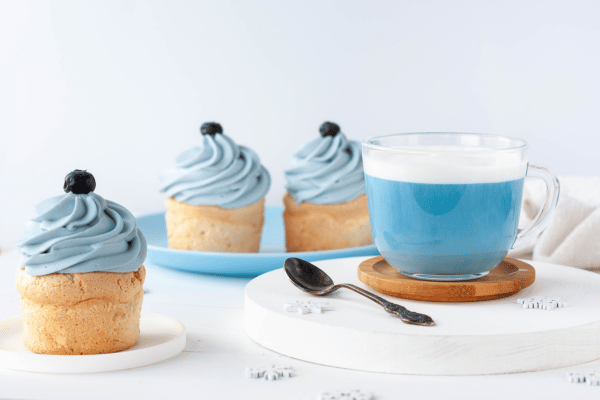
Blue butterfly pea flowers Cupcake
When cooking with butterfly pea flowers, it’s important to keep in mind that the color can change depending on the pH level of the ingredients used. For example, adding acidic substances like lemon juice or lime juice can change the blue color to purple due to the natural pH-sensitive pigments in the flowers.
Overall, blue butterfly pea is a versatile and fun ingredient to experiment with in the kitchen, allowing you to create visually appealing dishes and drinks while potentially benefiting from its antioxidant properties.
Blue butterfly pea flowers have been traditionally used in certain cultures for skincare purposes due to their potential antioxidant and anti-inflammatory properties. While scientific research on the direct effects of blue butterfly pea flowers on the skin is limited, the flower contains certain compounds that may contribute to skin health. Here are some potential ways in which blue butterfly pea flowers could be beneficial for the skin:
Antioxidant Protection: Blue butterfly pea flowers contain anthocyanins, which are powerful antioxidants. Antioxidants help protect the skin from free radical damage caused by environmental factors such as UV radiation, pollution, and stress. This protection can potentially slow down premature aging, reduce the appearance of fine lines, and promote a more youthful complexion.
Anti-Inflammatory Effects: The anti-inflammatory properties of blue butterfly pea flowers may help soothe and calm irritated or inflamed skin. This could be especially helpful for those with sensitive or acne-prone skin.
Skin Brightening: The flower’s natural blue color comes from a water-soluble blue pigment called anthocyanin. When used topically, it may have skin-brightening properties, which could help reduce the appearance of dark spots and promote a more even skin tone.
Hydration: Blue butterfly pea flowers are often used in skincare formulations like serums, creams, and masks. When incorporated into products, they may contribute to skin hydration, helping to maintain moisture and improve skin texture.
Natural Cleansing: In some cultures, blue butterfly pea flowers are used as a natural cleanser for the skin. The mild cleansing properties can help remove dirt and impurities without causing excessive dryness.
It’s important to note that while blue butterfly pea flowers show promise for skin health, scientific evidence is still limited, and individual results may vary. As with any natural ingredient, it’s essential to patch test the product on a small area of your skin before using it more widely, especially if you have sensitive skin or known allergies.
If you’re interested in trying blue butterfly pea flowers for skincare, you can look for commercial skincare products that contain the flower extract or create your own DIY skincare formulations using dried or powdered butterfly pea flowers. Always consult with a dermatologist or skincare professional.
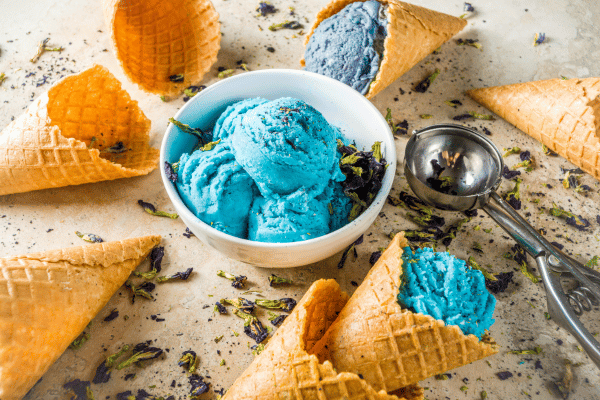
What are the foods cook using blue butterfly pea in Sri lanka
In Sri Lanka, blue butterfly pea flowers, known locally as ” Nil katarolu “are used in a variety of culinary applications to add a natural blue color to dishes and beverages. Here are some traditional Sri Lankan foods and drinks that can be prepared using blue butterfly pea:
Nil katarolu Tea: Similar to butterfly pea flower tea in other countries, in Sri Lanka, too, the flowers are used to brew a herbal tea called “Nil katarolu Tea” or The tea is made by steeping dried butterfly pea flowers in hot water. Lemon juice is often added to change the color from blue to purple.
Nil katarolu Rice: Blue butterfly pea flowers are used to color rice dishes, giving the rice grains a vibrant blue hue. In Sri Lanka, they might use Nil katarolu flowers to make blue rice for special occasions and celebrations.
Nil katarolu Syrup: The flowers can be used to make a blue syrup that is added to drinks and desserts to give them a vibrant blue color. The syrup can be drizzled over ice cream, used in beverages, or as a topping for pancakes and waffles.
Nil katarolu Iced Tea: Aparajita flower tea, when chilled over ice, can be served as a refreshing iced tea on hot days.
Nil katarolu Mocktails and Cocktails: The blue color of the Aparajita flowers makes them a perfect natural food coloring for mocktails and cocktails in Sri Lanka. Bartenders and mixologists may use the Aparajita syrup or tea to add a unique blue hue to their concoctions.
“Nil katarolu milk Rice” is a traditional Sri Lankan dish that combines rice, coconut milk, and the natural blue coloring of the Aparajita (blue butterfly pea) flowers.
Nil katarolu Noodles: In Sri Lankan cuisine, colored noodles made using Nil katarolu flowers may be used in certain dishes.
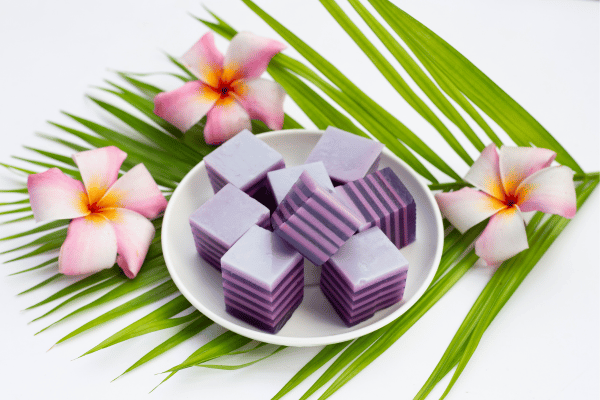 Butterfly pea and coconut milk jelly
Butterfly pea and coconut milk jelly
As with any culinary use of butterfly pea flowers, the color can change depending on the pH level of the ingredients used, so the addition of acidic substances like lemon juice may alter the color from blue to purple.
In Sri Lanka, Nil katarolu flowers are not only used for their visual appeal but also for their potential health benefits. Like in other cultures, they are believed to have antioxidant properties and may have some traditional medicinal uses.
It’s worth noting that culinary traditions can vary from region to region and household to household, so the use of blue butterfly pea flowers in Sri Lankan cuisine might differ slightly based on local customs and preferences.







